Why a Cat is the Purrfect RV Companion
Yes, You Can Train A Cat
Contrary to what most people think, camping with a cat is not only possible but fun!
Cats are incredibly adaptive creatures and with a little patience and persistence, you can get a cat to do about anything. The easiest way to get a cat used to a RV as a home is to start off with a kitten. But, if you have a mature cat that you want to take with you, there are several steps you can take to make the transition easy on you and the cat.
Don’t automatically assume that your feline friend is going to freak out when put in the RV to travel. You might be pleasantly surprised to discover that after just a short time, the cat will be comfortable with what’s going on and settle right in.
Leash Training Is Most Important for Safety
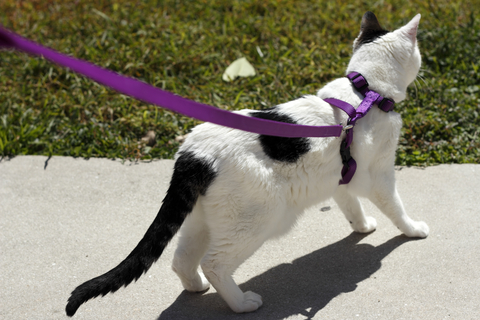
The first thing I would recommend is to train your cat to walk on a harness/leash setup. This is easy to do and most cats will get the hang of it fairly quickly. I’ve trained my last 2 cats to walk on the leash and both got to the point where they loved it. They behaved about as well as any dog on a leash! The harness and leash will give you control over the cat while training it and when venturing outside to explore.
Crate/Carrier Training
If your cat hates the sound of a motor and detests riding in a car, the best option is to buy a crate, get the cat comfortable with being in the crate and then take the cat out in a vehicle.
To get your cat used to a crate, place the crate in your home in an area he frequents. Leave the door open for several days. Cats love to investigate. Hopefully, he will investigate it and claim it as his own. While he is checking the crate out, be careful not to bump the crate or do anything to make the cat wary of it. You can also try placing his food or a special treat inside the door of the crate. Once your cat has accepted the crate, close the door about halfway but still leave it open enough that he can exit if he chooses to. If all is going well, work up to the point that the door is gradually closed but not locked again, so he can push on it to exit. Finally, over time, get so you can actually latch the door. Let him out as soon as he wants out. Then gradually lengthen the time before you let him out until he will quietly wait to be released. If your cat becomes frightened during this process, just back off a few steps and try again. If you’re using a wire crate, sometimes draping a towel over the crate top and sides makes the crate more den-like.
Time For Road Tests
Now that the cat is OK with being crated, you need to get the cat used to traveling in the crate long before you embark on your RV trip. Place the crate in the car and secure it with the seatbelt and take the cat for several short trips around the neighborhood. If the cat cries don’t respond to it. Just let the cat cry and ignore it. Make your trips increasingly longer, until the cat is comfortable with the idea of traveling. Then you can try the RV. Start off with the cat in the crate. Not only will the crate keep the cat safe while traveling, cats like to “den” and they will seek comfort in the closed in space. Be sure to secure the crate with a seatbelt or securely bungee cord the crate to something inside the RV so that it doesn’t become a missile if there is an accident or sudden stop.
Now that you’re traveling down the highway with the cat in the RV, it’s up to you to decide if the cat is going to be allowed to move about or if it should be kept in the crate until you stop moving. If you want the cat to be able to move about, I strongly suggest you keep him in the harness with the leash attached until he learns where he can and cannot go – like under the drivers feet. And again, cats can learn and every cat I’ve known understands “No”. You can reinforce a “No” with a squirt of water from a spray bottle. I’ve used this training “tool” on my cats for years and now all I have to do is pick up the sprayer and they immediately stop what they’re doing! Just don’t spray them in the face.
Over time you will know what works and what doesn’t.
Stopping An Escape
The next challenge is how to keep the cat from bolting out the door. Again, the harness and leash should be on the cat before the door opens. Some cats that have been indoor cats their entire lives don’t care about going outside. If your cat has been an indoor/outdoor cat then you can provide a way for them to enjoy the outdoors and keep out of danger with a cat enclosure. There are several types to choose from and all different price levels. Just make sure that the cat won’t be able to squeeze through any openings. RVers don’t want to lug cumbersome things around, so be sure to consider portability and where you can to store the enclosure before buying one. Or, if you’re crafty, build a slide out CATIO for your fur baby!
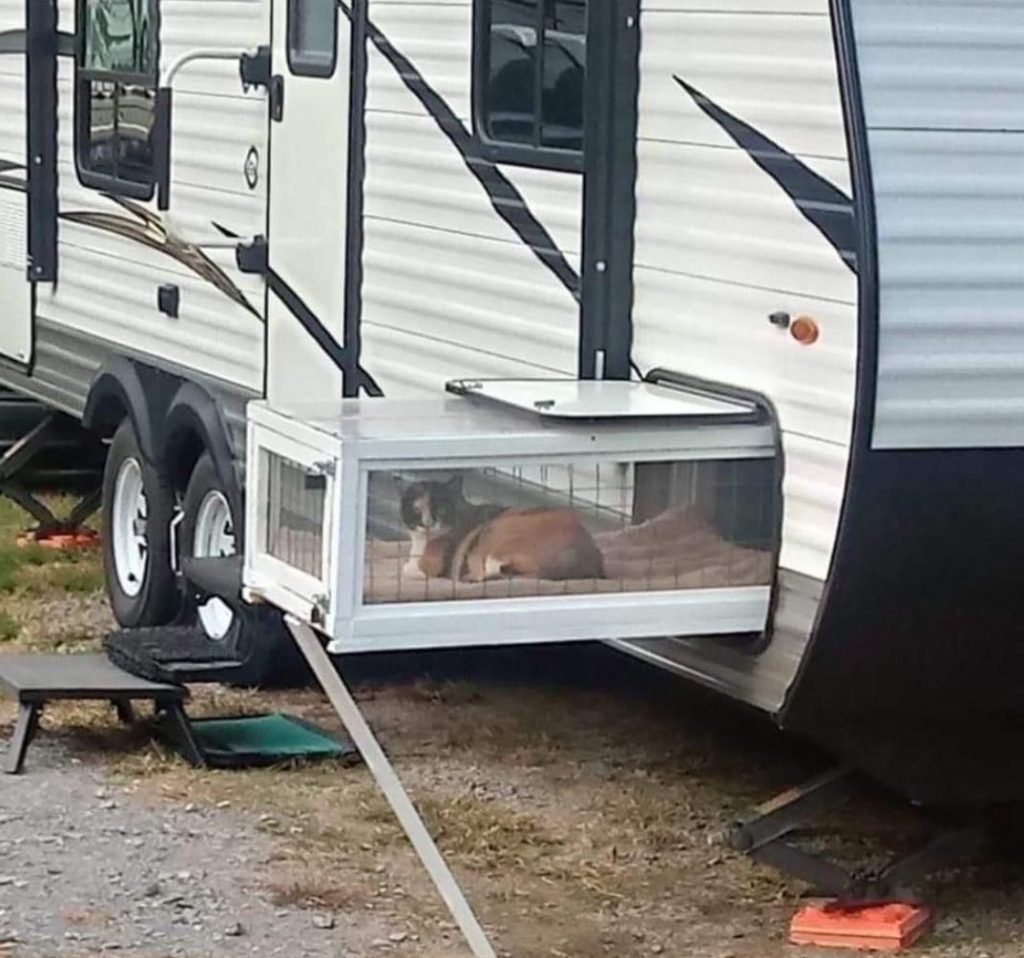
About that Litter Box
And finally, what to do about the litter box! This is always one of the first questions on an RVer’s mind – and we have it solved! We have owned a travel trailer and motorhome, and it has worked in both campers. We buy two rubber storage bins for pennies at a thrift store, and stack them together. Then we fill the top one halfway with a large bag of kitty litter. The bins fit perfectly in our shower stall. When the time comes, we simply dump the top one out, grab the clean one underneath and fill it, rinse the other bin out, let it dry and stack it under the new litter bin. The only downfall is the weight to pick it up when you shower daily. You also need to be careful that no kitty litter goes down your drain, so plug it up or cover it while the litter box is in there.
There are other alternatives for your kitty – just depends on the amount of work you feel like doing!
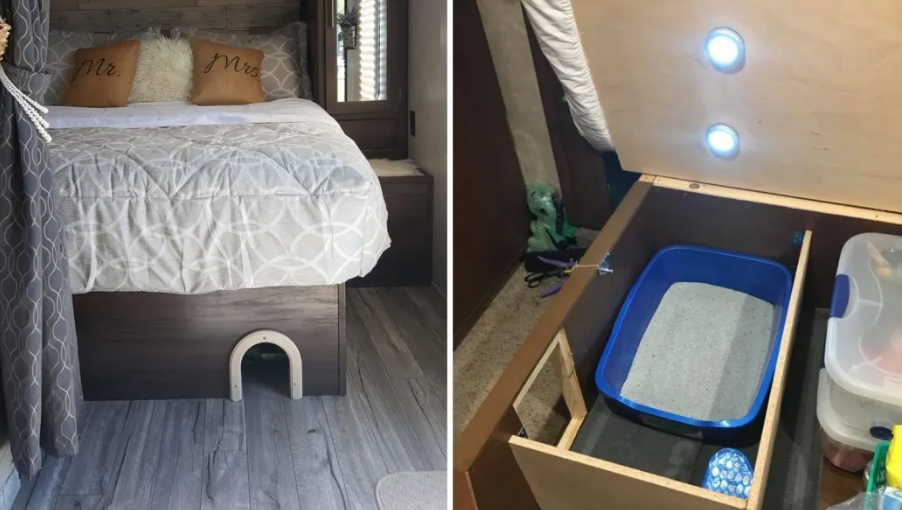
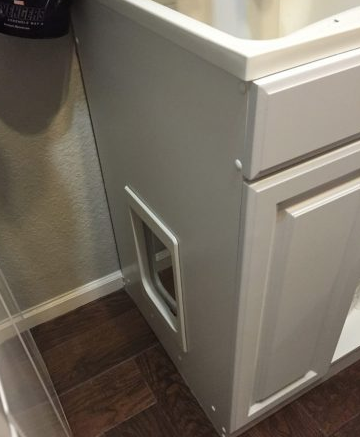
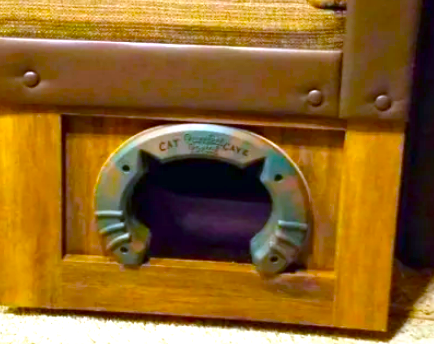
More Important Safety Tips
As a last bit of advice, always travel with your cat’s medical records in case he should need medical attention during your trip. Some campgrounds are requiring evidence of rabies vaccinations for dogs and might require it for your at as well. Since your cat could come in contact with other animals it should be vaccinated for rabies.
Finally, make sure not to leave any animals alone in your RV if it becomes too warm. Do not rely on your air conditioner because it can malfunction or its power supply be compromised while you are away. (There can be area power outages, tripped campground circuit breakers, and malfunctioning generators. Animals will overheat in a very short time in a closed-up RV on a warm day with tragic consequences.
Cats are possibly the best traveling companion for an RVer! You don’t have to stop to let them potty and you will never be asked to leave the campground because of them barking!








